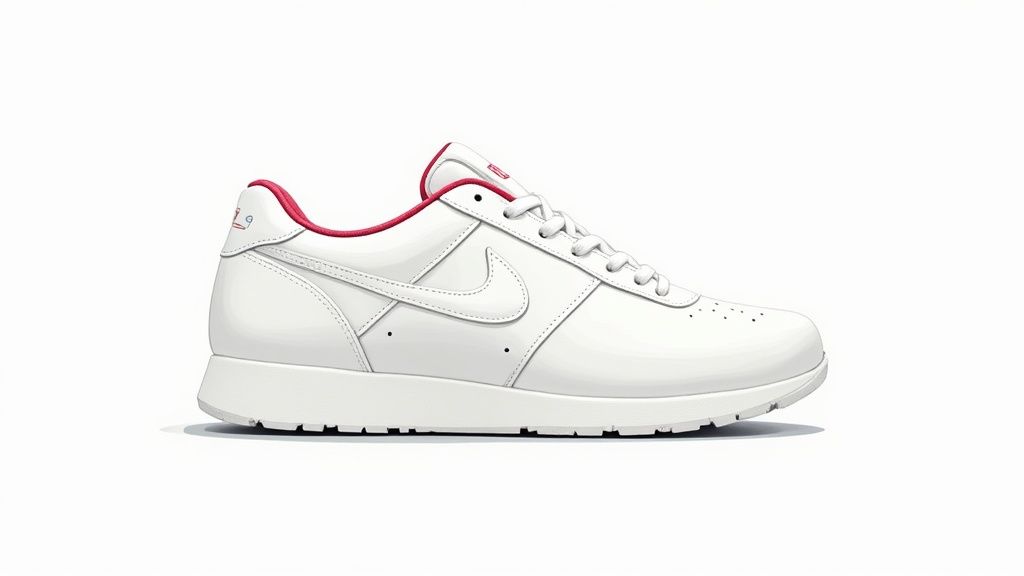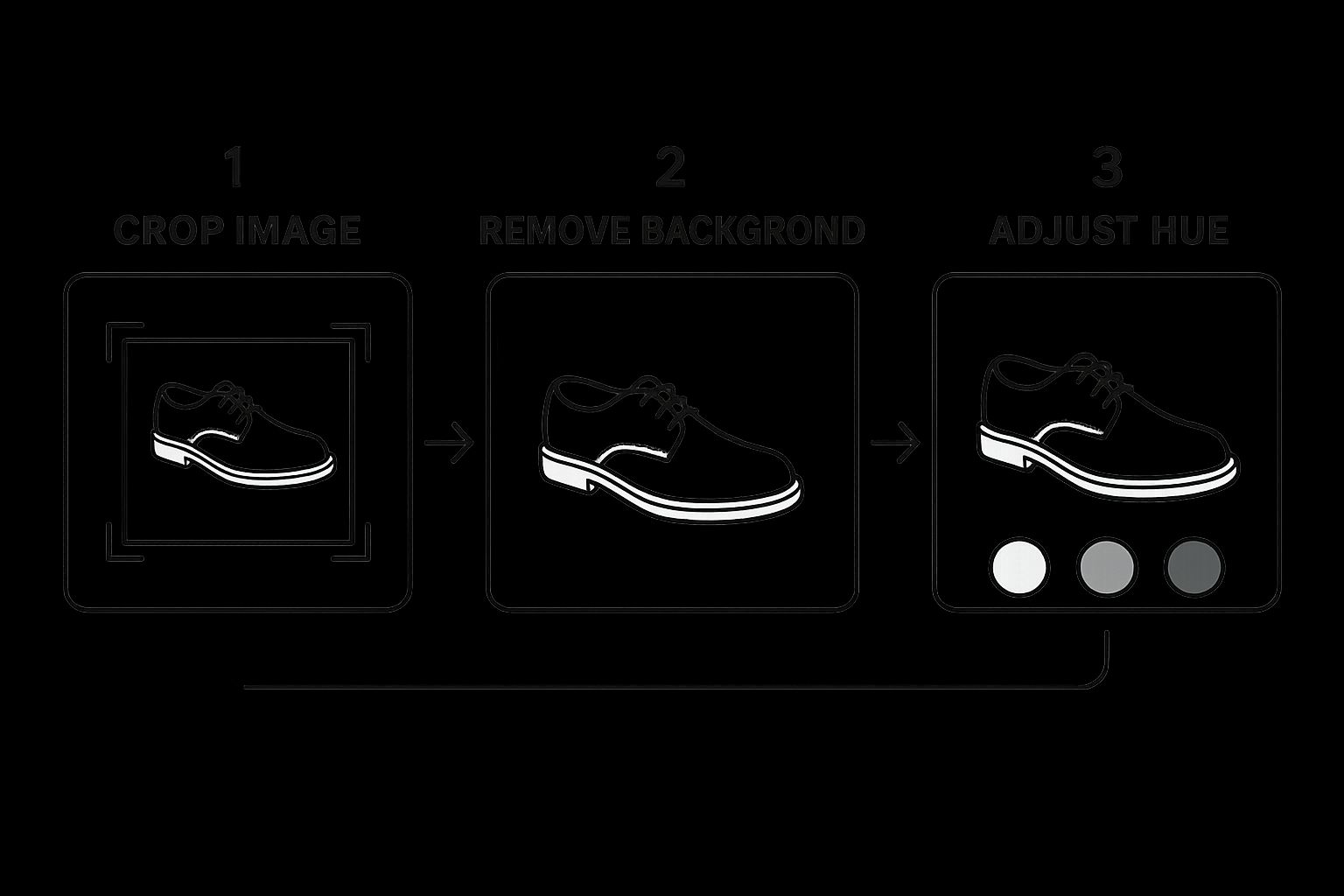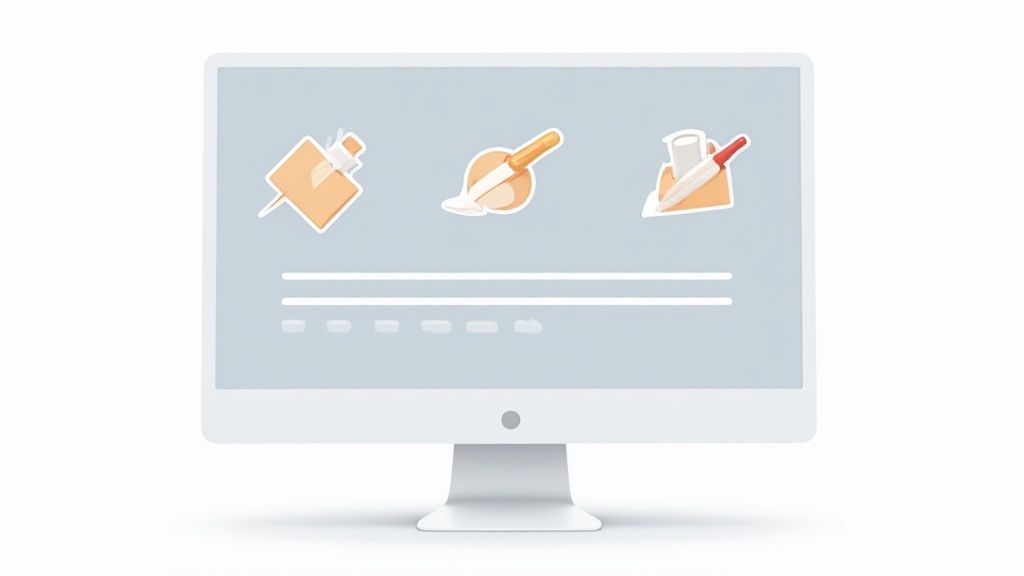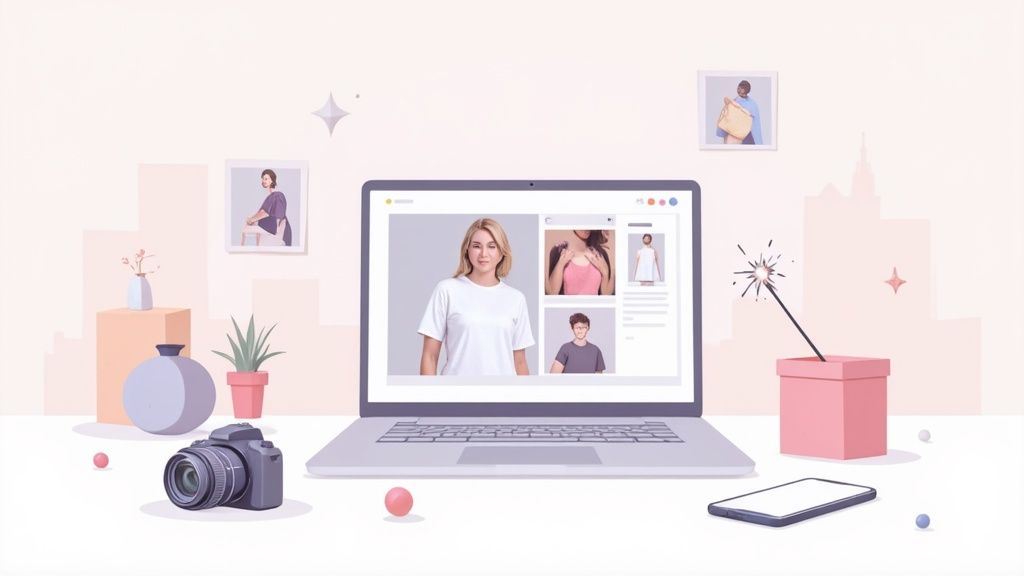When we talk about professional e-commerce image editing, we're talking about more than just sprucing up a few pictures. It's the craft of turning a standard product photo into a powerful tool that builds trust with your customers, sets the right expectations, and makes your items pop in a sea of competitors.
This process transforms your images from simple pictures into genuine business assets that can directly sway a buyer's decision and even help lower your return rates.
Why Better Product Images Drive More Sales
Let's dig deeper than the old saying, "good pictures sell more." There's real psychology behind it. Online, your product photos are the very first interaction a customer has with your item. Think of them as your digital handshake, your virtual storefront, and your 24/7 salesperson, all in one.
Great visuals don't just display what you're selling—they build instant credibility and shape a shopper's entire perception of your brand. This is precisely why e-commerce image editing should be at the core of your business strategy, not just an afterthought. It’s what powers a consistent brand narrative across every single product you list. When every item is shot and edited with the same professional care—consistent lighting, crisp backgrounds, true-to-life colors—it sends a clear message of reliability and quality.
Building Trust and Setting Expectations
Let's be honest: inconsistent or blurry photos create doubt. A potential customer might worry if the item will actually look like the picture, which often leads to them leaving your site or abandoning their cart. Professionally edited photos, on the other hand, set crystal-clear expectations.
This simple act of visual honesty can dramatically cut down on returns, saving you a ton of logistical pain and lost profit.
Put yourself in the customer's shoes for a moment:
- Clarity builds confidence. When a product’s color, texture, and size are shown accurately, a shopper feels much more secure hitting that "Add to Cart" button.
- Professionalism implies quality. A polished image suggests a high-quality product from a seller who cares.
- Consistency creates a better experience. A uniform look across all your listings makes your brand recognizable and your store much easier to shop.
The Growing Demand for High-Quality Visuals
This isn't just a hunch; the numbers back it up. The global market for image editing software was valued at a staggering USD 9.8 billion in 2023 and is expected to more than double by 2033. This explosion in growth highlights just how critical polished visuals have become for anyone selling online. You can learn more about these image editing software market trends on datahorizzonresearch.com.
The payoff for getting this right is huge. While many sellers understandably worry about the cost of professional product photography, today's AI-powered tools have made getting those high-end results easier and more affordable than ever. This levels the playing field, allowing even small businesses to compete visually with the big names and create a shopping experience that turns casual browsers into repeat customers.
How to Shoot Photos Primed for AI Editing

Here's a secret that experienced sellers know: great product photos start long before you open up an editing app. While AI tools are incredibly powerful, they perform best when you give them a quality image to work with. You don't need a professional studio, but a little thoughtful prep work goes a long, long way.
Think of it this way: AI is brilliant at enhancing and transforming, but it can't fix a fundamentally bad photo. A blurry, poorly lit shot will always be a struggle, even for the smartest software.
Focus on Clean Lighting
If you get one thing right, make it the lighting. Your goal is soft, even light that shows off your product without creating harsh shadows or blown-out hotspots. Those dark, hard shadows are a nightmare for AI background removal tools, often resulting in jagged edges or chunks of your product getting accidentally erased.
You can get professional-level lighting without breaking the bank.
- Go Natural: The best light is often free. Set up your product near a large window on an overcast day for a beautiful, diffused glow. Just be sure to avoid harsh, direct sunlight.
- DIY Your Diffuser: If you’re using a lamp, you can soften its light by putting a thin white sheet or even parchment paper between the bulb and your product. It’s a simple trick that mimics the effect of an expensive softbox.
A well-lit photo gives the AI a clear, unambiguous view of your product, which makes every edit that follows much more accurate.
Keep Your Composition Simple and Consistent
When you're behind the camera, the product is the star of the show. A busy or cluttered background just creates more work for both you and the AI. Your best bet is to use a plain, solid-colored backdrop, like a white poster board or a clean, neutral-colored wall. The clean contrast makes it incredibly easy for tools to cleanly isolate your product.
Consistency is also a non-negotiable for building a professional brand. After all, nearly 75% of consumers expect a consistent experience, and that starts with your visuals.
Try to shoot every product from the same set of angles (front, side, 45-degree view) and at the same distance. This simple discipline creates a cohesive and trustworthy catalog that helps customers compare items and feel confident in their purchase.
Avoiding Common Photo Mistakes
Finally, just be mindful of a few common pitfalls that can derail your editing before you even start. Make sure your product is in sharp focus—a blurry photo is basically unsalvageable.
Also, watch out for reflections on shiny items like jewelry, glass, or electronics. Move your lights and camera around to minimize glare. While AI can do a lot, removing complex reflections is one area where it can still struggle. A few extra seconds during the shoot will save you a massive headache later.
Your AI-Powered Image Editing Workflow
Alright, you’ve got your raw photos prepped and ready to go. Now comes the fun part: turning them into images that actually sell. Forget spending hours wrestling with complicated software. The modern way to handle e-commerce image editing is all about speed, precision, and consistency, and it's powered by some seriously smart AI.
Let's walk through how this works in the real world, using a tool like ProdShot as our example. The whole point is to get from a basic, just-shot photo to a polished, marketplace-ready image in a matter of minutes, not hours. This isn't just a nice-to-have anymore; it's essential to keep up.
The demand for these kinds of tools is exploding for a reason. The global photo editing software market was already valued at around USD 1.15 billion in 2024 and is expected to hit USD 1.82 billion by 2034. That growth is being driven by sellers like you who need faster, more effective ways to create great product visuals. You can dig into the numbers in this photo editing software market analysis on market.us.
Instantly Create Compliant Backgrounds
One of the biggest time-sucks in traditional editing has always been background removal. For marketplaces like Amazon, a pure white background isn't just a style choice—it's a hard rule for your main product shot. This is where AI really shines. It can identify your product and wipe out the background with incredible accuracy in seconds.
Picture this: you just finished shooting a new line of leather handbags against a simple grey wall. The old way involved painstakingly tracing every curve with a pen tool. Now, you just upload the photo to an AI editor. Almost instantly, you get a perfectly cut-out product on a transparent background, ready for a clean white or any other color you want.
Automate Color Correction and Cleanup
Getting the color right is critical. If a customer buys a "burgundy" sweater that shows up looking fire-engine red, you're practically guaranteeing a return. AI-driven editing tools automate color correction by analyzing the image, balancing the tones, and making sure what people see on screen is what they get in the box.
These tools also handle the little things. They can spot and remove tiny flaws like dust specks, fingerprints, or weird reflections on a shiny surface. These were the kinds of tedious touch-ups that used to take ages to fix by hand.

Generate Realistic Lifestyle Scenes
This is where things get really interesting. Creating lifestyle photos—the kind that show your product being used in a real-world setting—used to mean booking expensive photoshoots with models and props. Not anymore. Now, you can generate them from your desk.
A brand once found that just by adding lifestyle context to their product photos, they saw their add-to-cart rates jump by as much as 35%. AI puts that kind of power in everyone's hands.
Take that handbag photo with its new transparent background. You can simply tell the AI to place it on a marble kitchen counter next to a steaming latte and a pair of sunglasses. Within moments, you have a beautiful, believable lifestyle shot that’s perfect for your website, ads, or social media feed.
These are the images that help customers truly connect with your product and imagine it in their own lives. If you want to get into the nitty-gritty of how this works, we have a complete breakdown of photo editing services for ecommerce that you'll find helpful.
To really see the difference, let's compare how long these common editing jobs take the old way versus with an AI helper.
Manual vs AI-Powered Editing Task Comparison
| Editing Task | Manual Method (e.g., Photoshop) | AI-Powered Method (e.g., ProdShot) |
|---|---|---|
| Background Removal | 5-30 minutes per image. Requires meticulous path-tracing and refinement. | <10 seconds per image. One-click, fully automated process. |
| Color Correction | 2-10 minutes per image. Involves manual adjustments to levels, curves, and hue/saturation. | <5 seconds per image. Automated analysis and one-click correction. |
| Basic Retouching | 5-20 minutes per image. Requires spot healing, cloning, and patching imperfections by hand. | <15 seconds per image. AI detects and removes common flaws automatically. |
| Lifestyle Scene Creation | Hours to Days. Requires planning, props, a location, and a photoshoot. Post-production is extra. | 1-2 minutes per image. Generate dozens of variations using simple text prompts. |
The takeaway here is pretty clear. The time savings alone are massive, especially when you’re dealing with dozens or hundreds of product SKUs. This isn't just about working faster; it's about being able to create higher-quality, more diverse visual content without the traditional costs or complexity.
Optimizing Images for SEO and Platforms

So, you've taken some killer product shots. They're sharp, well-lit, and show off your product from every angle. But here’s a hard truth I’ve learned over the years: a visually stunning photo is only half the battle.
If customers and search engines can’t find it, even the most perfect image won't drive a single sale. This final optimization stage is where many sellers drop the ball, but getting it right gives you a massive edge over the competition. It’s about more than just pixels; it's about playing by the rules of the web.
Meeting Platform-Specific Requirements
Every online marketplace has its own rulebook for images, and ignoring them is a fast track to getting your listings buried or even rejected. Think of these specs as the technical uniform your photos have to wear to get in the door.
Here’s a quick rundown of what the big players demand:
- Amazon: They are famously strict. Your main image must have a pure white background (that’s RGB 255, 255, 255). And for that all-important zoom feature that shoppers love, your image needs to be at least 1000 pixels on its longest side. No exceptions.
- Shopify: You get a bit more creative freedom here, but consistency is key. I always recommend using a square (1:1) aspect ratio for a clean, professional grid on your store homepage. Aim for 2048 x 2048 pixels to keep them looking crisp on high-resolution screens.
- Etsy: This platform is all about the visuals, so you have more flexibility. However, I’ve found that a horizontal orientation, usually a 4:3 ratio, works best to avoid your images being awkwardly cropped on category and search pages.
Adhering to these specifications isn't just about avoiding penalties. It’s about professional presentation. A perfectly sized image on Shopify looks intentional, while a zoomable, white-background photo on Amazon builds immediate trust and meets the expectations of seasoned online shoppers.
To make this easier, I've put together a quick-reference table. It's always a good idea to double-check the platform's official documentation, as these things can change, but this guide covers the current essentials.
Platform Image Specification Quick-Guide
| Platform | Recommended Dimensions (pixels) | Max File Size | Background Requirement |
|---|---|---|---|
| Amazon | 1000px on longest side (2560px recommended) | 10 MB | Main image must be pure white (RGB 255,255,255) |
| Shopify | Up to 4472 x 4472 (2048 x 2048 recommended) | 20 MB | Flexible; white/light grey recommended for consistency |
| Etsy | 2000px on the shortest side (min) | 10 MB | Flexible, but clean & uncluttered is best practice |
| 1080 x 1080 (Square), 1080 x 1350 (Portrait) | 30 MB | N/A (Lifestyle shots perform well) | |
| 1000 x 1500 (2:3 ratio) | 20 MB | N/A (High-quality vertical images are key) |
Getting these technical details right from the start saves a ton of headaches later and ensures your products look their absolute best, no matter where they're being viewed.
Mastering Image SEO for Better Visibility
Beyond the marketplace rules, your images are powerful SEO assets. Search engines like Google can't "see" your photos the way we do, so you have to give them text clues to help them understand what they're looking at. This is where your file names and alt text come into play.
To really get your products seen, you need to master some basic on-page SEO best practices. It starts before you even upload the image.
Never upload a photo with a generic name like IMG_8472.jpg. That tells Google absolutely nothing. Instead, rename it with a descriptive, keyword-rich name. Something like blue-leather-crossbody-handbag.jpg is perfect.
Next up is the alt text, or alternative text. This is the text that shows up if an image fails to load and, more importantly, it's what screen readers use to describe the image to visually impaired users. It’s also a huge signal to search engines. A solid alt text for our handbag example would be: "Side view of a blue leather crossbody handbag with a gold chain strap."
Choosing the Right File Format
Finally, let's talk file formats. This choice directly impacts your image quality and, crucially, your site's loading speed—a make-or-break factor for both user experience and SEO rankings.
- JPEG: This is your workhorse for most product photos. It offers a great balance of quality and compression, keeping file sizes small so your pages load quickly.
- PNG: Use this format when you absolutely need a transparent background. Think logos or images you want to layer on top of a colored backdrop. Just be aware that the file sizes are typically larger than JPEGs.
- WebP: This is a more modern format from Google that offers fantastic quality with even smaller file sizes than JPEG or PNG. If your platform supports it, using WebP is a surefire way to speed things up.
The need to quickly tweak and optimize images for different platforms is why the mobile photo editing market is booming. It hit a staggering USD 4.1 billion in 2023 and is on track to reach USD 7.8 billion by 2032, fueled by sellers who need to get these details right while on the move.
Common Mistakes to Avoid in Image Editing
https://www.youtube.com/embed/Oljb1Sg9xdI
Getting the hang of e commerce image editing tools is one thing, but knowing how to use them to actually sell products is a whole different ballgame. Even with incredible AI tools at our disposal, it’s all too easy to make simple mistakes that can scare away customers and even tarnish your brand's reputation.
One of the biggest blunders I see all the time is over-editing. You want your product to look its best, which is understandable. But in the process, you might crank up the saturation until the colors are unrealistic or smooth out textures until the item looks like a plastic replica. This creates a huge gap between expectation and reality for your customers, and that's a fast track to bad reviews and expensive returns.
The Problem with Inconsistency
Another classic pitfall is visual inconsistency. When your product photos all have slightly different lighting, backgrounds, or color grading, your whole shop can start to feel a bit messy and untrustworthy. It's a subtle detail, but it has a massive psychological impact.
Think about it: nearly 75% of consumers say they expect a consistent experience wherever they interact with a brand. That starts with your images. A unified, professional look tells shoppers you’re serious and reliable.
To get that cohesive feel, you just need a simple style guide for yourself:
- Stick to one lighting setup. Whether you're using natural light from the same window or a basic two-light kit, keep it identical for every shoot.
- Use the same background. A clean white or light gray background is the industry standard for a reason. It creates a clean, uniform look that makes your products pop.
- Keep your colors consistent. Figure out the right color correction settings for one product and apply those same basic adjustments across the board. This ensures all your colors look accurate and belong together.
Ignoring the Mobile Shopping Experience
Forgetting about mobile shoppers is probably the most costly mistake of all. More and more people are buying from their phones, where screens are small and attention spans are even smaller. An image that looks stunning on a 27-inch monitor can be a blurry, confusing mess on a smartphone.
A busy lifestyle shot or a photo where the product is just a tiny speck is an instant scroll-past for a mobile user. You have to edit with the small screen in mind, making sure your product is the star of the show, no matter the device.
Your photos need to grab attention in a split second. That means cropping in tight, using simple compositions, and making sure the key features are crystal clear. Keep these common traps in mind, and you'll be well on your way to creating visuals that don't just look good, but also build lasting trust with your customers.
If you want to see how the pros handle this, our breakdown of professional product photo editing services offers some great insights.
Your Questions, Answered
Jumping into AI-powered tools for your product photos can feel like a big leap. You've probably got some questions, and that's completely normal. Let's walk through some of the most common things people ask when they're getting started.
I'm Not a Photographer. Can I Really Use These Tools?
Absolutely. That's the whole point of them. While starting with a decent photo always helps (think clear, good lighting), you definitely don't need a pro-level skillset. These tools are built to do the heavy lifting for you.
They take on the tedious stuff that used to require years of practice in programs like Photoshop, like flawlessly removing a background or getting the lighting just right. Your job is simply to provide a solid starting image, and the AI takes it from there, turning a simple smartphone picture into something that looks like it came from a studio.
What's This Going to Cost Me?
The pricing is all over the map, which is actually good news because it means there's a fit for every budget. Most AI editors work on a subscription or credit-based system. Many even have free plans to get you started, though they might limit how many photos you can edit.
For paid plans, you could be looking at anything from $10 to over $100 a month. It really depends on how many images you're churning out and whether you need access to the more advanced bells and whistles. When you stack that up against the cost of hiring a professional retoucher for every single product, the value is obvious.
It’s this accessibility that really changes things. Suddenly, small shops can create visuals that look just as good as what the big retailers are putting out, all without the massive budget. It’s about leveling the playing field.
Can AI Actually Create Believable Lifestyle Shots?
It sure can, and honestly, this is where the magic really happens. You can take your standard product photo—the one on a boring white background—and let the AI drop it into a convincing real-world setting.
Imagine you're selling a watch. You can generate images of it on someone’s wrist walking through a city, resting on a nightstand, or sitting next to a coffee cup on a desk. You often just type in what you're imagining, and the AI builds the scene around your product. This is how you create a whole gallery of marketing shots without ever booking a location or hiring a model.
Ready to see this in action? ProdShot uses AI to turn your basic product photos into images that sell, and it only takes a few seconds. Ditch the complicated software and start making visuals that actually drive conversions.
Try ProdShot for free and see what it can do for your store!

